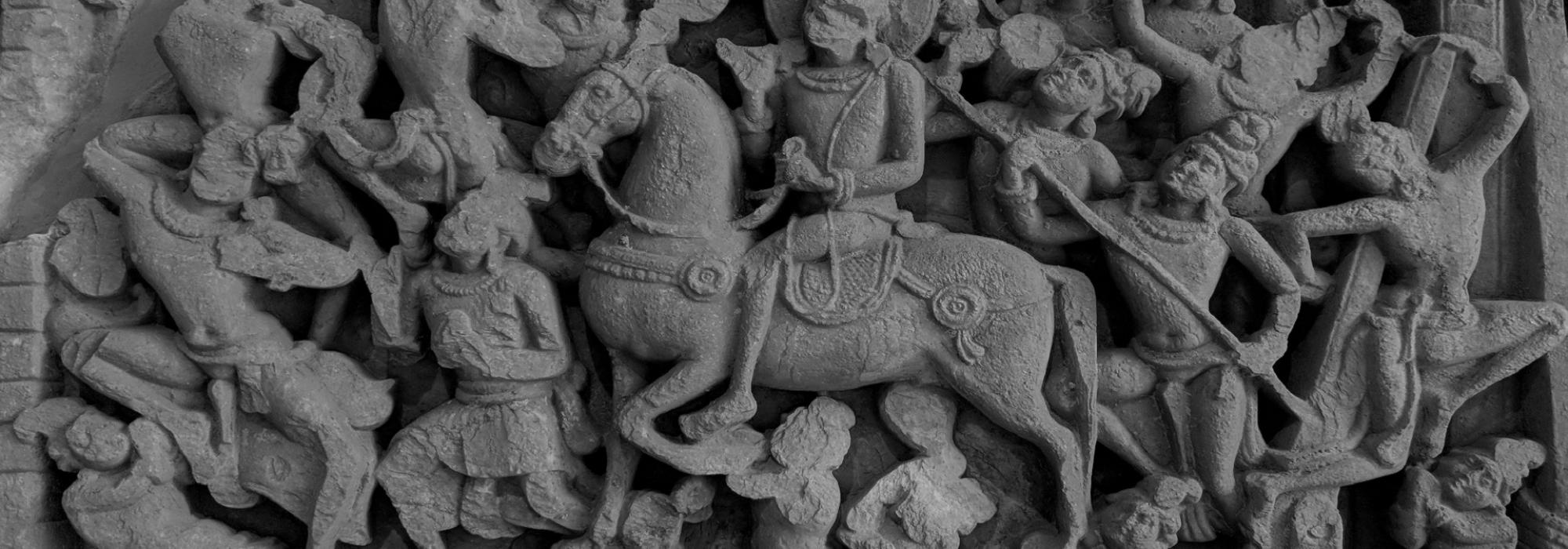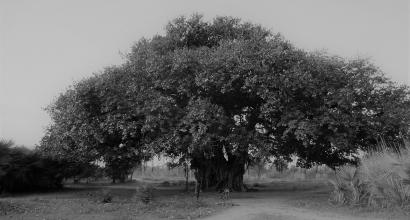His younger contemporary, Abhinavagupta, of Kashmir, is a giant in every sense of the word. By his own admission, he was not short of guidance, and it shows in his works. In his commentaries, he fondly mentions two of his Gurus: Bhaṭṭatauta, who taught him Nāṭya-śāstra,[1] and Bhaṭṭendurāja, who taught him Dhvanyāloka.[2] Both were from Kashmir and, by Abhinavagupta’s own description, were masters of Aesthetics. Abhinavagupta is best known for his commentaries Locana and Abhinavabhāratī, on Dhvanyāloka and Nāṭya-śāstra respectively. In these commentaries, he comes across as a highly original thinker who has extended the boundaries of both the works he has commentated upon.[3] He harmonized the two streams of Alaṅkāra-śāstra, one developing around the concept of rasa and primarily relying on the stage, and the other developing around the concepts of alaṅkāra and dhvani, and primarily relying on classical literature. Commentating on Dhvanyāloka and synthesizing it further with rasa from Nāṭya-śāstra, Abhinavagupta proclaimed that rasa-dhvani is the ultimate aim of all poetry. Similarly, he also contributed to the philosophical analysis of rasa itself which had been advanced by Bhaṭṭa-ḻollaṭa (utpatti-vāda), Śrīśaṅkuka (anumiti-vāda) and Bhaṭṭanāyaka (bhukti-vāda). He advanced the abhivyakti-vāda to explain the process of realizing rasa. According to him, the spectator or connoisseur should first have an unbiased reciprocative mind with an intense spring of latent emotions honed by worldly experiences.[4] When such a person immerses himself in the character on stage, where the actor appears not in his own form but in that of the character, the character’s vibhāvas and anubhāvas naturally become universalized; the spectator will then have an instant emotional connect or hṛdaya-saṃvāda with the character on stage, which will invoke the correct sthāyibhava in him as if reflecting in a mirror. The spectator will enjoy this as it is already universalized. So, according to Abhinavagupta, the vibhāvas and anubhāvas, through the medium of vyañjanā-vyāpāra, unveil rasa.[5] In this unveiling, the latent sthāyibhava shines through as rasa. But, once the stimuli of vibhāvas and anubhāvas are removed, rasa also disappears. And so, rasa is not a thing to be analysed in isolation; it is the unveiling of latent sthāyibhavas in an unbiased reciprocative connoisseur under the stimuli of vibhāvas and anubhāvas. Apart from these, he also established the framework of śānta-rasa, the ninth rasa by resolving the disputes surrounding its sthāyibhava. Because of these three contributions—establishing the pre-eminence of rasa-dhvani, abhivyakti-vāda, and establishing śānta-rasa—and of course, his immortal commentaries, Abhinavagupta became the dominant figure in Alaṅkāra-śāstra for future generations.
At this point, we must make a respectable mention of another lively character of Alaṅkāra-śāstra from Kashmir, Kṣemendra, who was also a student of Abhinavagupta. He lived around the middle of the tenth century CE. He was a polymath who is known to have composed more than thirty works.[6] Of these, four works are related to poetics: Kavi-karṇikā, Suvṛtta-tilaka, Aucitya-vicāra-carcā, and Kavi-kaṇṭhābharaṇa. Of these, Kavi-karṇikā is not available. Suvṛtta-tilaka is a work dedicated to the analysis of metres with some points of interest. Aucitya-vicāra-carcā is a very intimate discussion of the concept of aucitya. While it does not contribute anything new to the understanding of the concept beyond Dhvanyāloka, it nevertheless expands on the concept with plenty of examples. It is probably the only work in Alaṅkāra-śāstra that is wholly dedicated to the concept of aucitya. Kavi-kaṇṭhābharaṇa is a friendly manual for poets. All in all, although Kṣemendra did not contribute anything qualitative to Alaṅkāra-śāstra, he comes across as one of the finest representatives of the all-round excellence of the literary traditions of Kashmir.[7]
While the momentous contributions of Kuntaka and Abhinavagupta were taking shape, on the frontiers, Maharajadhiraja Jayapaladeva had realised the dangers that the principality of Ghazni would cause. He, therefore, decided to actively attack and debilitate the enemy. He is probably the only Indian ruler to pursue such a strategically aggressive posture towards the Islamists. The first such attack on Ghazni was during 986–87 CE. In this instance, Jayapaladeva had reached the gates of Ghazni with a large army and had Sabuktigin and his son Mahmud in despair, when a snowstorm and rain would force him to conclude a truce and return. The truce was never meant to last and Sabuktigin raided Lamghan, the most populous province of the Shahi kingdom. Upon this, Jayapaladeva appealed to the Indian kingdoms for help. According to Ferishta, the Chahanamas, Tomaras and Chandellas supplied him with money and men. This army then met the Islamists in combat near Langham, where a ferocious battle was fought and Jayapaladeva was defeated. Sabuktigin annexed the entire territory between Lamgham and Peshawar and introduced Islam among the people, who were probably followers of Buddhism. Sabuktigin died in 997 CE and, after a brief struggle with his brother, Sabuktigin’s son Mahmud ascended the throne of Ghazni in 998 CE. He first consolidated his position against the Samanids and by 999 CE, had received the recognition of the Caliph. After this, Mahmud is known to have taken a vow to attack India every year.
Eleventh Century CE
The first three decades of this century are nothing but the story of Mahmud’s repeated raids into India and the obstinate resistance of the Shahis to him. It started in 1000 CE with Mahmud raiding and capturing some fortresses in the neighbourhood of Peshawar. In the next year, 1001 CE, he again marched to Peshawar with his army. Jayapaladeva moved his army to Peshawar and was waiting for more reserves to join him. Mahmud seized the opportunity and attacked right away. Jayapaladeva was not just defeated, but also captured along with his sons and grandsons and suffered detention in Mirand. Mahmud annexed the province of Peshawar and marched on the capital Udbhandapura. There is known to have been large scale slaughter and the Hindus seem to have retired to the hills to reorganise themselves. According to Al-`Utbi, after some time, Mahmud made peace with Jayapaladeva in return for fifty elephants and retained his grandson Sukhapala to ensure the treaty is honoured. Mahmud also seems to have converted Sukhapala and renamed him as Nawasa Shah. Anandapala is known to have secured the release of his father Jayapaladeva after paying the ransom demanded. However, this insult was too great for a kṣattriya of the calibre of Jayapaladeva. And so, the legendary Maharajadhiraja Paramabhattaraka Jayapaladeva ended up immolating himself on a funeral pyre of his own free will. In future Indian history, there would be many instances of the royal womenfolk immolating themselves to avoid a life of rapine and slavery under Islamists. However, this is the only instance where a kṣattriya would kill himself to wash away the stain of being captured and let alive by an Islamist. In the light of future alliances by some Indic kingdoms with Islamists, Jayapaladeva’s conduct seems extraordinary. Although we can speculate about the possibilities if Jayapaladeva had decided to fight another time instead of killing himself, that should not deter us from saluting an extraordinary warrior who upheld all that is great about the Sanātanic tradition. His son and successor Anandapala continued to hold the grim vigil at the borders. In 1005–06 CE, Mahmud led an expedition to Multan and requested passage through Anandapala’s territory. Anandapala refused and this resulted in a battle near Peshawar between the Shahis and Mahmud. Mahmud inflicted a sound defeat on the Shahis and Anandapala fled to the Kashmiri hills. Mahmud then marched ahead to Multan and forced the Islamic ruler to accept his superiority and pay tribute. At about the same time, Mahmud got news of the invasion of his kingdom by the Turks under Ilak Khan. He would rush back to Ghazni leaving his Indian possessions under Nawasa Shah or Sukhapala. Sukhapala quickly renounced Islam, returned to the Hindu fold and dismissed all Muslim officers. However, Anandapala, inexplicably, decided not to team up with Sukhapala and inflict damage on Mahmud when he was stretched by the Turks. Even more inexplicably, he is known to have offered Mahmud help in dealing with the Turks. Anandapala would soon find out the Islamic style of reward for such stupidity.[8]
In 1007 CE, Mahmud came back to punish Sukhapala for his rebellion. Although Sukhapala fled to the hills, he is known to have been captured, stripped of his possessions, and imprisoned for life. In 1008 CE, Mahmud marched against Anandapala. Anandapala is known to have collected an army to which the rulers of Ujjain, Gwalior, Kanauj, Kalinjar and Ajmer are known to have contributed. According to Ferishta, after a ferocious battle where the Hindus held the upper hand, Anandapala’s elephant turned unruly under a shower of arrows and started retreating.[9] The Hindu armies seem to have taken this as a sign for leaving the battlefield and given up the battle. The Islamists are known to have pursued them all the way till Nagarkot and engaged in large scale slaughter. The Hindus also surrendered the fort of Nagarkot, which is known to have held plenty of treasure, which Mahmud transported to Ghazni. After this defeat, the Shahis lost more territory and then moved their capital to Nandana, in the Salt range. By 1010 CE, Mahmud had led a successful raid into Narayanpur in Rajputana, destroyed temples and carried back plunder. He also crushed the ruler of Multan. Anandapala also entered a treaty with Mahmud and agreed to pay an annual tribute in return for not attacking the Shahi domains. With this treaty in force, Anandapala gave Mahmud free passage on his way to Sthaneshwar, or Thanesar, to destroy the Chakraswamin temple. Mahmud then took the main deity to Ghazni be trampled upon by Islamists, a practice religiously followed by successive Muslim invaders. Anandapala apparently gave Mahmud hospitality on the way back also. Anandapala died in 1012 CE and his son Trilochanapala ascended the throne. He was more in the mould of his grandfather Jayapaladeva and was not keen to be a supplicant to the Islamists. And so, Mahmud invaded the Shahis again in the winter of 1013 CE. Trilochanapala, surprised by this invasion, put his army under his son Bhimapala and asked them to guard the narrow mountain passes. He then called for his vassals and allies to join them with men. The Kashmiri king Sangramaraja sent his commander Tunga with his army. However, according to Kalhana, Tunga did not heed to Trilochanapala’s wisdom and made strategically suicidal moves with the result that his army was defeated. According to Kalhana, despite the setback, Trilochanapala and Bhimapala battled ferociously, but were defeated after a long and intense battle. Both retired to the hilly district of Lohara in the Kashmir Valley to reorganize and fight again. In the meantime, Mahmud plundered the Shahi capital of Nandana and marched on towards the Kashmir valley in pursuit of Trilochanapala. Trilochanapala tried to resist, but eventually escaped to Eastern Punjab, probably Sirhind, to fight another day. Mahmud plundered the Kashmir valley, took many prisoners and a large amount of booty. It is said that the number of prisoners were so large that they were sold at very cheap prices as slaves in Ghazni.[10] Mahmud returned again to Kashmir in 1015 CE to conquer Lohara or Lohkot, which he could not conquer despite a sustained siege. He is also known to have suffered immense damage on the way back.[11] It is quite possible that Abhinavagupta, who died in 1016 CE, witnessed these two invasions of his motherland by Islamists. But probably he had finished his life’s work by then. With that, the evolution of Alaṅkāra-śāstra was mostly complete. It is poignantly poetic that the grim vigil of the Shahis against fearful odds lasted till this evolution was complete. What remained to be done were a few footnotes and finishing touches, which happened during the reign of the Lohara dynasty over Kashmir.
As seen already, with Sangramaraja repulsing Mahmud’s attacks against Lohkot in 1015 CE, Mahmud never again returned to the perilous terrain of the Pir Panjal mountains. This enabled Kashmir to enjoy another 250 years of Hindu rule, despite continuous internal conflicts and rebellion, when the Islamists turned their attention to Central India.[12] After his failure in capturing Lohkot, Mahmud came back again towards the end of 1018 CE, this time passing through Punjab and subduing everyone on the way. However, Trilochanapala, who was ruling Eastern Punjab, would not accept Mahmud’s superiority and retires to the Paramara kingdom of Malwa to fight another day. Mahmud then marched to the Hindu holy city of Mathura, destroyed all the temples and idols, pillaged the city for twenty days and reduced the city to ashes. From there, he marched on to Kanauj. The Pratihara ruler Rajyapala, in a shameful departure from the great traditions of his family, fled Kanauj.[13] Mahmud destroyed the city, desecrated the temples and slaughtered the population. After a few more victories, Mahmud is said to have returned to Ghazni in 1021 CE with 20,000,000 dirhams, 53,000 prisoners of war and 350 elephants.
[1] Bhaṭṭatauta is known to have composed a work on poetics called Kāvya-kautuka, which is no longer available. The parts of that work that Abhinavagupta quotes in his commentaries indicate that it must have been a classic. Even Hemacandra’s work carries some gems of Bhaṭṭatauta.
[2] Abhinavagupta reserves very lofty praise for Bhaṭṭendurāja, calling him ‘vidvatkavi-sahṛdaya-cakravartī.’ He goes further and classifies Bhaṭṭendurāja in the same league as Vyāsa, Vālmīki, and Kālidāsa. However, since we do not have any work of Bhaṭṭendurāja available today, we cannot verify the truth behind this claim of Abhinavagupta.
[3] He is also known to have written a commentary Kāvya-kautuka-vivaraṇa, on Kāvya-kautuka, composed by his guru Bhaṭṭatauta. Unfortunately, neither the commentary nor the original work itself is available.
[4] In the Western tradition, S T Coleridge and William Wordsworth introduced a complementary concept termed “willing suspension of disbelief.”
[5] Here, he has alloyed the vyañjanā-vyāpāra concept of Ānandavardhana in explaining the realization of rasa. This is another instance of Abhinavagupta harmonizing the Nāṭya-śāstra tradition with the Alaṅkāra-śāstra tradition.
[6] He has composed condensed versions of Rāmāyaṇa and Mahābhārata as Rāmayaṇa-mañjarī and Mahābhārata-mañjarī, respectively. He is one of the few who has given due attention and respect to Brhatkathā along with Rāmāyaṇa and Mahābhārata. He is also among the very few who has written a work dedicated to the puruṣarthas: Catur-varga-saṅgraha. Apart from these, he has contributed extensively to the genres of Satire / Humour (Kalāvilāsa, Narma-mālā, Deśopadeśa, and Samaya-mātṛkā), devotional poetry (Avadāna-kalpalatā and Daśāvatāra-carita), and didactic poetry (Darpa-dalana, Cāru-caryā, Sevya-sevakopadeśa, etc.)
[7] Another shining star of Kashmir from our period of interest is Bhallaṭa, who is the unrivalled monarch of the genre of poetry called anyokti (allegory). He was a court poet of Avantivarma and fell out of favour during Shankaravarma’s time. His Bhallaṭa-śataka is an absolute classic of Sanskrit literature.
[8] While many think Prithviraj letting Ghori go unharmed was the first instance of misplaced chivalry, it was probably Anandapala who was the first one to shower undeserved generosity on a sworn Islamist foe. If Anandapala had followed the aggressive posture of his father, he would have probably attacked Mahmud right at the time he was under pressure from the Turks. At any rate, no proud father should be offering help to a foe who had captured his son and held him as ransom for any length of time. Jayapaladeva would probably have considered this as a bigger insult to a Kshatriya than mere defeat on the battlefield.
[9] Reference to similar incidents of elephants turning unruly and Hindu rulers losing battles are many. Swifter Muslim cavalry seem to have targeted Hindu chiefs on elephants to make a quick statement and cause confusion. Hemachandra Vikramaditya seems to have lost for similar reasons in the second battle of Panipat. Aliya Ramaraya seems to have lost the battle of Talikota for the same reason.
[10] Slave trade of captured Hindus in Arabian markets would become a most profitable enterprise for the Islamists till the nineteenth century. Even now, most blue collar Asian labourers in Arabic countries are technically treated like slave labour.
[11] Probably for these reasons, he never concentrated on Kashmir again. Probably, it was also because he had an easier route into Central and Western India, where he saw easier pickings.
[12] A lot of the credit here should go to the dogged Indic resistance of the Central Indian kingdoms like Chahanamas, Paramaras and Chandellas. If they had not resisted so intensely, the Islamization of Kashmir, which happened in the early 1300s would have happened in the early 1100s.
[13] Enraged by this, the Chandella legend Vidyadhara is known to have captured and killed Rajyapala.
(The author expresses deep gratitude to Śatāvadhānī Dr. R Ganesh for his insights into Alaṅkāra-śāstra over the years and for his critical review of this essay. Likewise, the author is also grateful to the young scholar Sri B N Shashi Kiran for his review and editing assistance.)
To be continued.















































